Medically reviewed by Dr. Ramesh Gaddam, M.D. — Written by Sumalatha, D.N.H.E
1. Nutrition
Nutritional Profile of Pork Rinds (Per 1 oz / 28 grams Serving)
| Nutrient | Amount |
|---|---|
| Calories | 150-160 kcal |
| Protein | 8-9 grams |
| Fat | 9-10 grams |
| Saturated Fat | 3.5-4 grams |
| Carbohydrates | <1 gram |
| Fiber | 0 grams |
| Sugars | 0 grams |
| Sodium | 400-500 mg |
| Iron | 1% DV* |
| Magnesium | 1-2% DV* |
| Zinc | 1-2% DV* |
| Vitamin B12 | 2-3% DV* |
* DV = Daily Value (based on a 2,000 calorie diet)
5. Impact on Existing Health Conditions

Eating Pork Rinds have a great impact on existing health conditions like:
Diabetes
Pork rinds are low in carbohydrates, making them a seemingly safe snack for people with diabetes.
However, the high fat content can still affect blood sugar levels indirectly.
Consuming high-fat foods can lead to insulin resistance, where the body becomes less effective at using insulin to lower blood sugar levels.
Over time, this can contribute to more significant blood sugar fluctuations and make diabetes management more challenging.
Additionally, pork rinds can lead to weight gain, further complicating blood sugar control.
Kidney Disease
Individuals with kidney disease must carefully monitor their sodium and protein intake. Pork rinds are high in both sodium and protein, which can exacerbate kidney problems:
High Sodium Content:
Excessive sodium intake can lead to increased blood pressure and fluid retention, putting additional strain on the kidneys.
For people with compromised kidney function, this can accelerate the progression of kidney disease and increase the risk of heart-related complications.
High Protein Content:
While protein is essential for overall health, too much protein can be harmful to those with kidney disease.
High protein intake can increase the workload on the kidneys, potentially leading to further damage and decreased kidney function over time.
Gout
Gout is a form of arthritis characterized by sudden, severe attacks of pain, redness, and tenderness in joints, often at the base of the big toe.
It is caused by elevated levels of uric acid in the blood, which can form crystals in the joints.
High-purine foods contribute to increased uric acid levels, and while pork rinds are not the highest in purines, they can still contribute to the overall purine load:
Purine Content:
Pork, including pork rinds, contains purines, which are broken down into uric acid in the body.
Consuming high-purine foods can trigger gout attacks in susceptible individuals.
Therefore, those with gout or a predisposition to gout should limit their intake of pork rinds to reduce the risk of flare-ups.
Summary:
For individuals with existing health conditions such as diabetes, kidney disease, or gout, the consumption of pork rinds can pose significant risks.
The high fat content can lead to blood sugar fluctuations and weight gain, complicating diabetes management.
The high sodium and protein content can exacerbate kidney disease, increasing blood pressure and further damaging kidney function.
Additionally, the purine content in pork rinds can contribute to elevated uric acid levels, increasing the risk of gout attacks.
Awareness of these impacts is essential for individuals with these conditions to make informed dietary choices and manage their health effectively.
6. Benefits vs. Risks
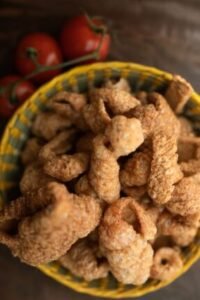
Comparison of Benefits and Risks of Pork Rinds.
Protein Intake
Pork rinds are rich in protein, with approximately 8 to 9 grams per one-ounce serving.
Protein is essential for muscle repair and growth, immune function, and hormone production.
Including pork rinds in moderation can help individuals meet their daily protein needs, especially for those following low-carb or ketogenic diets.
Satiety and Weight Management
The combination of protein and fat in pork rinds can promote feelings of fullness and satiety, which may help curb cravings and reduce overall calorie intake.
This can be beneficial for weight management, as feeling satisfied can prevent overeating between meals.
Weighing Benefits Against Risks
While pork rinds offer some nutritional benefits, they also come with several health risks that should be considered:
High Calorie and Fat Content:
Regular consumption of pork rinds can contribute to excess calorie intake and potentially lead to weight gain, especially when not balanced with physical activity.
High Sodium Content:
The elevated sodium levels in pork rinds can increase blood pressure and contribute to cardiovascular issues, particularly for individuals with hypertension or heart disease.
Impact on Existing Health Conditions:
Pork rinds may exacerbate conditions like diabetes, kidney disease, and gout due to their high fat, sodium, and protein content.
Consideration of Portion Size and Frequency
To balance the benefits and risks of consuming pork rinds:
- Moderation: Enjoy pork rinds occasionally and in moderation to reap their protein benefits without overloading on fat and sodium.
- Portion Control: Stick to recommended serving sizes (about one ounce) to manage calorie intake and avoid excessive sodium consumption.
- Frequency: Limit consumption to occasional snacks rather than incorporating pork rinds into daily meals to minimize long-term health risks.
Summary
While pork rinds can provide a protein-rich snack option that promotes satiety and supports dietary goals, their high calorie, fat, and sodium content pose risks to overall health when consumed excessively.
Understanding and balancing these benefits and risks is essential for making informed dietary choices that promote overall well-being and minimize potential adverse health effects.
7. Healthier Alternatives
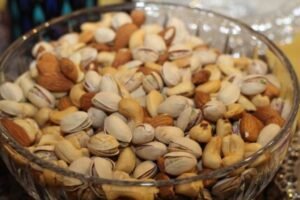
Mentioned below ar some of the healthy alternatives to Pork Rinds.
Nuts and Seeds
Nuts and seeds are nutrient-dense alternatives to pork rinds.
They provide healthy fats, protein, fiber, vitamins, and minerals.
Options like almonds, walnuts, and pumpkin seeds offer satiety and nutritional benefits without the high sodium and saturated fat content of pork rinds.
Vegetable Chips
Vegetable chips, such as kale chips or beet chips, are made from thinly sliced vegetables that are baked or lightly fried. They provide fiber, vitamins, and antioxidants while offering a crunchy texture similar to pork rinds. These chips can be seasoned with herbs and spices for added flavor without excessive sodium.
Air-Popped Popcorn
Air-popped popcorn is a whole grain snack that is low in calories and provides fiber. It can be seasoned with herbs, nutritional yeast, or a small amount of low-sodium seasoning for flavor. Compared to pork rinds, air-popped popcorn is lower in fat and sodium, making it a lighter snack option.
8. Making Healthier Pork Rinds at Home
We can make healthier Pork Rinds at Home by:
Baking Instead of Frying
To reduce the fat content of pork rinds, consider baking them instead of deep-frying. Here’s how you can make baked pork rinds:
- Prepare the Pork Skin: Start with fresh pork skin, removing excess fat. Cut into small pieces or strips.
- Seasoning: Season the pork skin with your preferred spices and seasonings. Options include salt, pepper, paprika, garlic powder, or any other seasoning blend.
- Baking: Preheat your oven to 325°F (160°C). Place the seasoned pork skin pieces on a baking sheet in a single layer.
- Bake: Bake for 30-40 minutes, or until the pork skin is crispy and puffed up. Keep an eye on them to prevent burning.
- Cool and Enjoy: Allow the baked pork rinds to cool before serving. They can be stored in an airtight container for several days.
Lower Sodium Recipes
To reduce the sodium content of pork rinds, use less salt during the seasoning process.
You can also explore alternative seasonings like herbs, spices, or nutritional yeast to enhance flavor without relying on salt. Additionally, avoid adding extra salt after baking or frying.
Summary
Choosing healthier alternatives to pork rinds, such as nuts and seeds, vegetable chips, and air-popped popcorn, can provide nutrient-rich snacks with lower fat and sodium content.
Making pork rinds at home by baking instead of frying allows for better control over ingredients and reduces the overall fat content.
Experimenting with lower sodium recipes ensures that these snacks remain delicious while promoting better health outcomes.
Frequently Asked Questions (FAQs)
People searched about Pork Rinds related questions are:
Are pork rinds healthy?
Pork rinds are high in protein but also contain high levels of saturated fats and sodium.
While they can provide a protein boost, their nutritional value should be considered in moderation due to potential health risks associated with excessive fat and sodium intake.
What are pork rinds made of?
Pork rinds are made from the skin of pigs. The skin is typically cooked to remove excess fat and then fried or roasted until crispy.
Do pork rinds count as meat?
Pork rinds are derived from the skin of pigs, which is technically considered part of the animal’s meat.
What is pork rind?
Pork rind refers to the crispy fried or roasted skin of a pig, often seasoned with salt or other flavorings.
Are pork skins vegetarian?
No, pork skins are not vegetarian as they are made from the skin of pigs, which are animals.
Do pork rinds taste like?
Pork rinds have a crunchy texture and a savory flavor, often enhanced by the frying process and seasoning.
Are pork rinds raw?
No, pork rinds are not raw. They are typically cooked through either frying or roasting before consumption.
What’s another name for pork rinds?
Another name for pork rinds is “chicharrones” in Spanish-speaking countries and some regions in the United States.
What is fried pig fat called?
Fried pig fat is commonly referred to as “pork cracklings” or “crackling.”
Is pig fat good or bad?
Pig fat contains a mix of saturated and unsaturated fats. While some fats are essential for the body, excessive consumption of saturated fats can contribute to health issues such as heart disease.
Why is pig fat so tasty?
Pig fat, especially when cooked, can impart a rich, savory flavor known as umami. This taste profile is appealing to many people.
Who invented pork skins?
The exact origin of pork skins is unclear, but they have been a traditional food in various cultures for centuries, especially in regions where pigs are commonly raised and consumed.
Is pork skin healthy?
Pork skin is high in collagen, protein, and fat. While it can provide certain nutritional benefits, its high fat and sodium content should be moderated to avoid health risks.
Can humans eat pork skin?
Yes, pork skin is edible and is consumed in various forms, including pork rinds and cracklings, in many cuisines around the world.
Who started eating pork?
The consumption of pork dates back thousands of years and has been a dietary staple in many cultures globally, including ancient civilizations and modern societies.
Do pork rinds go bad?
Pork rinds have a long shelf life when stored properly.
When kept in a sealed container or package in a cool, dry place, they can remain edible for several months.
However, exposure to moisture or air can cause them to become stale or lose their crispy texture over time.
What’s the difference between pork rind and pork crackling?
The terms “pork rind” and “pork crackling” are often used interchangeably, but there can be slight differences based on regional and culinary preferences:
- Pork Rind: Generally refers to the crispy fried or roasted skin of a pig, which puffs up during cooking to become light and airy. It is typically seasoned with salt or other flavors.
- Pork Crackling: Typically refers to a similar product but may denote a thicker, crunchier texture. In some regions, “pork crackling” may imply a denser, harder texture compared to “pork rind.”
Both terms essentially refer to the same snack made from pork skin, cooked until crispy and often seasoned for flavor.
Also Read :
Goat Meat (Chevon) Nutrition, Risks, Uses (10 Rich Benefits)
Medically reviewed by Dr. Ramesh Gaddam, M.D.

General Physician, Diabetologist, and Critical Care Specialist.
Discover more from Health Build-Up
Subscribe to get the latest posts sent to your email.
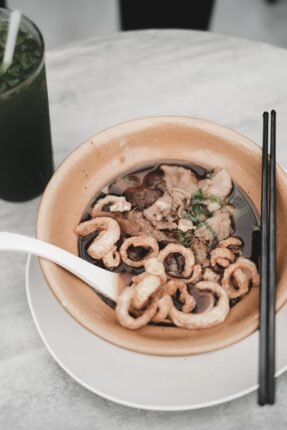
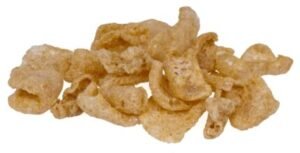



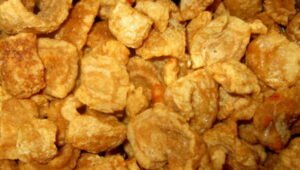
1 thought on “7 Side Effects of Eating Pork Rinds (Chicharrones)”
Comments are closed.